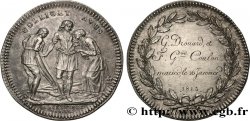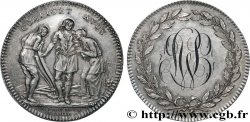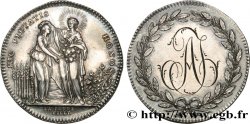fme_485563 - NORMANDY (GENTRY AND TOWNS OF...) Médaille, rosières de Canon, Mézidon et Vieux Fumé
170.00 €(Approx. 181.90$ | 146.20£)
Quantity
Add to your cart

Type : Médaille, rosières de Canon, Mézidon et Vieux Fumé
Date: n.d.
Metal : silver
Diameter : 33 mm
Orientation dies : 12 h.
Engraver GATTEAUX Nicolas-Marie (1751-1832)
Weight : 15,83 g.
Edge : lisse
Rarity : R1
Coments on the condition:
Aspect brossé. Présence de coups et rayures
Catalogue references :
Predigree :
Cet exemplaire provient de la collection C. Terisse
Obverse
Obverse legend : COLLIGET AVUS ; À L'EXERGUE EN DEUX LIGNES : LE BON CHEF DE/ FAMILLE.
Obverse description : Un laboureur aidant un domestique à conduire une charrue et soutenant une vieille femme ; au-dessous signature N. GA..
Obverse translation : (Il soutient le vieillard).
Reverse
Reverse legend : JFC / MARIES LE.
Reverse description : Initiales gravées dans une couronne de laurier.
Commentary
Exemplaire en frappe médaille et la tranche lisse. Ce revers est typique du XIXe siècle. En l’absence de poinçon, nous pouvons penser que cette fête a été célébrée et des jetons distribués au moins jusqu’en 1830. Mézidon-Canon (canton du même nom) et Vieux Fumé (canton de Bretteville-sur-Laize) sont situés dans le Calvados. Cette série de jetons de rosières compte 18 numéros selon Feuardent qui s’est appuyé sur un article de M. de La Sicotière, Les rosières en Basse-Normandie. Les couronnes décernées concernent les “bonne fille”, “bonne mère”, “bon vieillard” et “bon chef de famille”. Dans l'esprit de la célébration des vertus, une vingtaine furent élus de 1775 à 1785. Cette fête est instituée en février 1775 par Jean-Baptiste Elie de Beaumont (1732 à Carentan-1786 à Paris), jurisconsulte et avocat, défenseur ardent des protestants et adversaire de l’intolérance religieuse, auteur de mémoires judiciaires (notamment sur l'affaire Calas) qui lui confèrent une réputation européenne et la reconnaissance de Voltaire et de son épouse Anne-Louise Morin-Dumesnil. Jean-Baptiste Elie de Beaumont est par ailleurs membre de la loge des Neuf Sœurs et le père de Jean-Baptiste Armand Elie de Beaumont (1798-1874), une des grandes figures scientifiques de la géologie.








 Report a mistake
Report a mistake Print the page
Print the page Share my selection
Share my selection Ask a question
Ask a question Consign / sell
Consign / sell
 Full data
Full data



